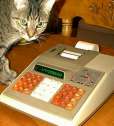Sharp PC-1450
| Datasheet legend
Ab/c:
Fractions calculation
AC: Alternating current BaseN: Number base calculations Card: Magnetic card storage Cmem: Continuous memory Cond: Conditional execution Const: Scientific constants Cplx: Complex number arithmetic DC: Direct current Eqlib: Equation library Exp: Exponential/log functions Fin: Financial functions Grph: Graphing capability Hyp: Hyperbolic functions Ind: Indirect addressing Intg: Numerical integration Jump: Unconditional jump (GOTO) Lbl: Program labels LCD: Liquid Crystal Display LED: Light-Emitting Diode Li-ion: Li-ion rechargeable battery Lreg: Linear regression (2-var. stats) mA: Milliamperes of current Mtrx: Matrix support NiCd: Nickel-Cadmium recharg. batt. NiMH: Nickel-metal-hydrite rech. batt. Prnt: Printer RTC: Real-time clock Sdev: Standard deviation (1-var. stats) Solv: Equation solver Subr: Subroutine call capability Symb: Symbolic computing Tape: Magnetic tape storage Trig: Trigonometric functions Units: Unit conversions VAC: Volts AC VDC: Volts DC |
| ||||||||||||||||||||||||||||||||||||||||||||||||||||||||
Sharp PC-1450
 What a find this was! I occasionally visit thrift stores and second-hand stores, looking for interesting calculators. The other day I had a very successful hunting trip: I returned home with an old scientific calculator (an APF Mark 50), a Casio FX-795P, and this rare Sharp PC-1450, all three machines in excellent working condition.
What a find this was! I occasionally visit thrift stores and second-hand stores, looking for interesting calculators. The other day I had a very successful hunting trip: I returned home with an old scientific calculator (an APF Mark 50), a Casio FX-795P, and this rare Sharp PC-1450, all three machines in excellent working condition.
The PC-1450 is a BASIC programmable calculator. It shares a highly useful feature with the TI-74: it is a calculator mode, in which its buttons function much like the buttons on an ordinary scientific calculator. In other words, you can invoke functions that operate on the contents of the display register, as opposed to having to key in BASIC expressions in immediate mode. (As to why the designers of many newer calculators abandoned this calculator mode altogether, opting for the more cumbersome "formula display" mode of operation, I really have no idea.)
I have no manual for this beast, but I was able to discover a few things about its built-in BASIC interpreter anyway. For one thing, the PC-1450 BASIC has PEEK and POKE keywords, indicating the possibility of accessing the hardware or doing machine language programming. For another, the BASIC is fairly advanced and complete, it even contains the DATA statement, which I found is missing from the BASIC implementation on many a handheld device.
As usual, I wrote a Gamma function program to test the capabilities of this machine. In it, I made use of the DATA statement to simplify the program a little. Here's the result:
10:DATA 76.18009172,9.5E-9 20:DATA -86.50532032,-9.4E-9 30:DATA 24.01409824,8E-10 40:DATA -1.231739572,-4.5E-10 50:DATA 1.208650973E-3,8.7E-13 60:DATA -5.395239384E-6,-9.5E-16 100:INPUT "X=",X 110:T=1 120:IF X>=0 THEN 160 130:T=T*X 140:X=X+1 150: GOTO 120 160:G=1.9E-10+1 170:FOR I=1 TO 6 180:READ C,D 190:G=G+(C+D)/(X+I) 200:NEXT I 210:G=LN (SQR (2*π)*G/X) 220:G=G-X-5.5+LN (X+5.5)*(X+.5) 230:PRINT EXP(G)/T

